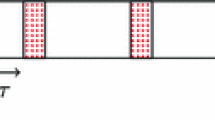Abstract
Sufficient protection of primary user is a challenging issue in cognitive radio networks. The probability of detection and the interference ratio (probability of collision) have been considered as the main constraints for primary protection in the literature. Based on the sensing parameters designed to comply with these constraints, secondary users are often considered to be able to use licensed bands without giving harmful interference to primary users. However, satisfying these constraints might not guarantee that each primary transmission (i.e., each busy period) is sufficiently protected. Obviously, if a large fraction of a busy period is interfered, the busy period may be subject to the useless transmission potentially degrading the quality of service of primary users. We suggest that the busy period impaired more than a certain ratio of so-called required per-transmission interference ratio (PTIR) is subject to the primary transmission failure (PTF), which has not been considered in the literature. As the first attempt, with the assumption of perfect sensing, the effect of sensing interval on the PTIR and PTF is investigated. The probability of PTF is derived as a function of sensing interval given the required PTIR. Then, given the required PTIR and probability of PTF, the optimal sensing interval that maximizes the throughput for secondary users is derived. Performance evaluation shows that primary users can be more protected with the optimal sensing interval obtained by using the proposed constraint.








Similar content being viewed by others
References
Mitola, J, III. (1999). Cognitive radio: Making software radios more personal. IEEE Personal Communications, 6(4), 13–18.
Haykin, S. (2005). Cognitive radio: Brain-empowered wireless communications. IEEE Journal on Selected Areas in Communications, 23(2), 201–220.
Liang, Y. C., Zeng, Y., Peh, E., & Hoang, A. T. (2008). Sensing-throughput tradeoff for cognitive radio networks. IEEE Transactions on Wireless Communications, 7(4), 1326–1337.
Peh, E., Liang, Y. C., Guan, Y. L., & Zeng, Y. (2009). Optimization of cooperative sensing in cognitive radio networks: A sensing-throughput tradeoff view. IEEE Transactions on Vehicular Technology, 58(9), 5294–5299.
Fan, R., & Jiang, H. (2010). Optimal multi-channel cooperative sensing in cognitive radio networks. IEEE Transactions on Wireless Communications, 9(3), 1128–1138.
Huang, S., Liu, X., & Ding, Z. (2009). Optimal transmission strategies for dynamic spectrum access in cognitive radio networks. IEEE Transactions on Mobile Computing, 8(12), 1636–1648.
Lee, W. Y., & Akyildiz, I. F. (2008). Optimal spectrum sensing framework for cognitive radio networks. IEEE Transactions on Wireless Communications, 7(10), 3845–3857.
Mehanna, O., & Sultan, A. (2011) Inter-sensing time optimization in unslotted cognitive radio networks, In Proceedings of International Conference on Telecommunications, pp. 238–243.
Hamid, M., & Björsell (2011) A novel approach for energy detector sensing time and periodic sensing interval optimization in cognitive radios, In Proceedings of International Conference on Cognitive Radio and Advanced Spectrum Management, pp. 1–7.
Kim, H., & Shin, K. G. (2008). Efficient discovery of spectrum opportunities with MAC-layer sensing in cognitive radio networks. IEEE Transactions on Mobile Computing, 7(5), 533–545.
Acknowledgments
This work was supported by the Inha University Research Grant.
Author information
Authors and Affiliations
Corresponding author
Rights and permissions
About this article
Cite this article
Choi, JK., Yoo, SJ. Optimal Sensing Interval Considering Per-primary Transmission Protection in Cognitive Radio Networks. Wireless Pers Commun 78, 1891–1903 (2014). https://doi.org/10.1007/s11277-014-2051-1
Published:
Issue Date:
DOI: https://doi.org/10.1007/s11277-014-2051-1




